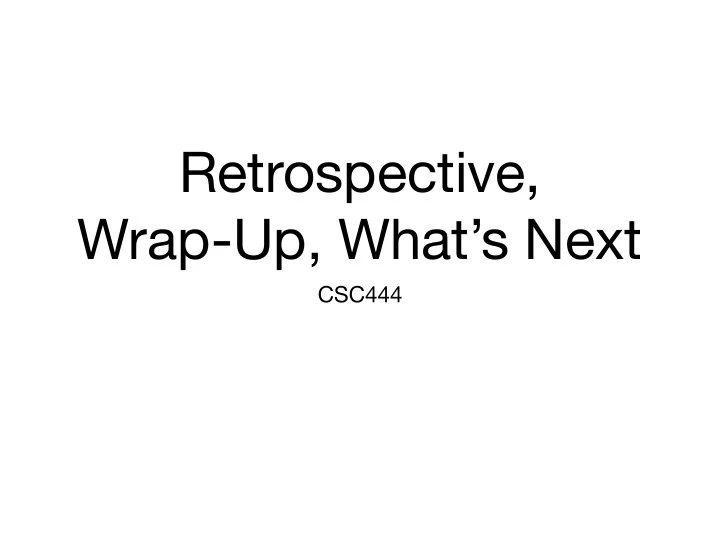

Retrospective, Wrap-Up, What’s Next CSC444
http://en.wikipedia.org/wiki/Anscombe%27s_quartet
We do visualization not because it’s pretty (although it can certainly be!), but because it works better
Mechanics
http://www.reddit.com/r/ProgrammerHumor/comments/2d62n3/javascript/
Why did we bother? • It’s the state of the art • (I know, right?! If you care, come help me fix it!) • It’s what actually gets used in the real world • What you learned in this class is exactly what the New York Times pros use
What did we leave out? • We learned how to use d3, and we learned how to write a part of it • But we didn’t go into a lot of detail of how d3 is implemented • If we want to improve things, we must first understand them • API design for visualization is important!
What did we leave out? • Web technologies for more complex graphics • Canvas, WebGL • Non-web technologies • Raw OpenGL, for when all else fails
SVG: ~1K points Canvas: ~50K points http://bl.ocks.org/mbostock/3680957 http://bl.ocks.org/mbostock/3681006
WebGL: ~1M points
CUDA/OpenGL: 32M points https://www.youtube.com/watch?v=NDLPoJsqqoA
Principles
Color Vision
How does your eye work?
OPPONENT PROCESS MODEL
Polar Lab (or HCL) • “Perceptually uniform”, like Lab • Transform ab to polar coordinates: radius is Chroma, Angle is Hue • Like HSV, but device-independent. All else being equal, think HCL first http://cscheid.net/static/20120216/hcl_frame.html
If you’re going to use the rainbow colormap, use an isoluminant version, quantize it, or both Bad Better
COLORBREWER
COLORGORICAL
SIMULTANEOUS CONTRAST
SIMULTANEOUS CONTRAST http://www.handprint.com/HP/WCL/tech13.html
PREATTENTIVENESS, OR “VISUAL POP-OUT”
Mixing is not always pre- attentive
Preattentiveness, only one-channel-at-a- time .
Cleveland/McGill perception papers
Cleveland/McGill perception papers Better to worse:
Pie Chart Bad, Scatterplot Good
Cleveland/McGill perception papers • Notice the “elementary perceptual tasks” • What about higher-level tasks?
Integral vs. Separable Channels Separable Integral color x location color x shape x-size x y-size color x motion size x orientation r-g x y-b Colin Ware, 2004, p180
Trivariate (!) Color Map (terrible, terrible idea) http://magazine.good.is/infographics/america-s-richest-counties-and-best-educated-counties#open
The best bivariate colormap I know http://www.nytimes.com/interactive/2014/11/04/upshot/senate-maps.html
Bivariate Color Maps are Possible, but Hard pay attention to the behavior of the variables you’re mapping from, and the behavior of the channels you’re mapping to.
Interaction • Interpret the state of elements in the UI as a clause in a query . As UI changes, update data Willett et al., TVCG 2007 (*)
Linked Brushing
Shneiderman’s “Visual information seeking mantra” Overview first, zoom and filter, then details-on-demand
Techniques
Regular Scatterplots • Every data point is a vector: v 0 v 1 v 2 v 3 • Every scatterplot is produced by a very simple matrix: 1 � 0 0 0 0 1 0 0 1 � 0 0 0 0 0 1 0
What about other matrices?
Dimensionality Reduction
Principal Component Analysis
Hierarchies http://jsfiddle.net/VividD/WDCpq/8/
Hierarchies http://www.cs.rug.nl/svcg/SoftVis/ViewFusion
Node-link diagrams http://christophermanning.org/gists/1703449/#/%5B10%5D50/1/0
Matrix Diagrams http://bost.ocks.org/mike/miserables/
Spatial Data http://ryanhill1.blogspot.com/2011/07/isoline-map.html
Contouring: isolines Approach to Contouring in 2D • Contour must cross every grid line connecting two grid points of opposite sign Identify grid Find crossings Get cell lines w/cross x Interpolate along grid lines x Primitives naturally chain together + - http://ryanhill1.blogspot.com/2011/07/isoline-map.html Oct 7, 2014, 530 - Introduction to Scientific Visualization
3D Contouring
Vector Field Visualization Spatial Data: Vector Fields
CS444: Data Visualization • Now you know why, how and how not to create visualizations for your data!
Recommend
More recommend